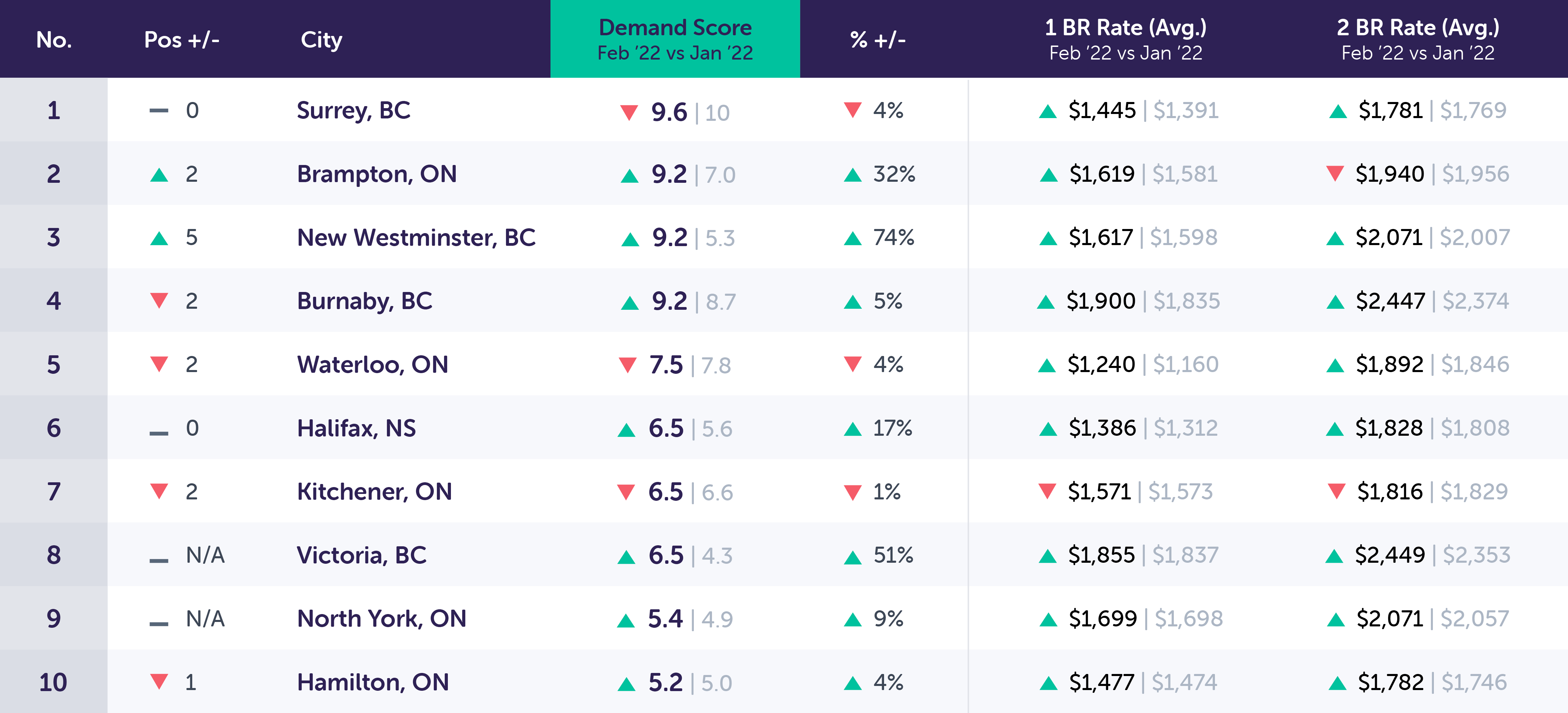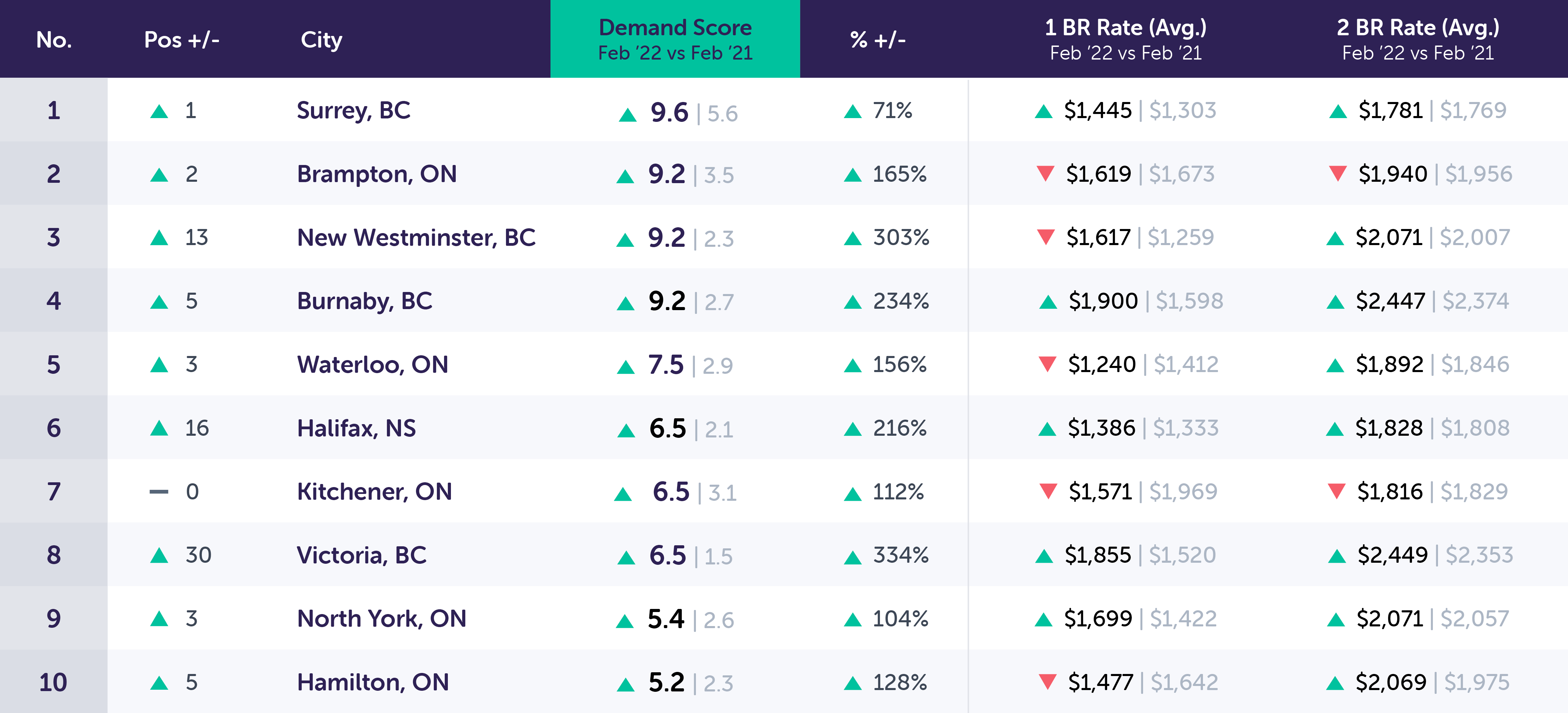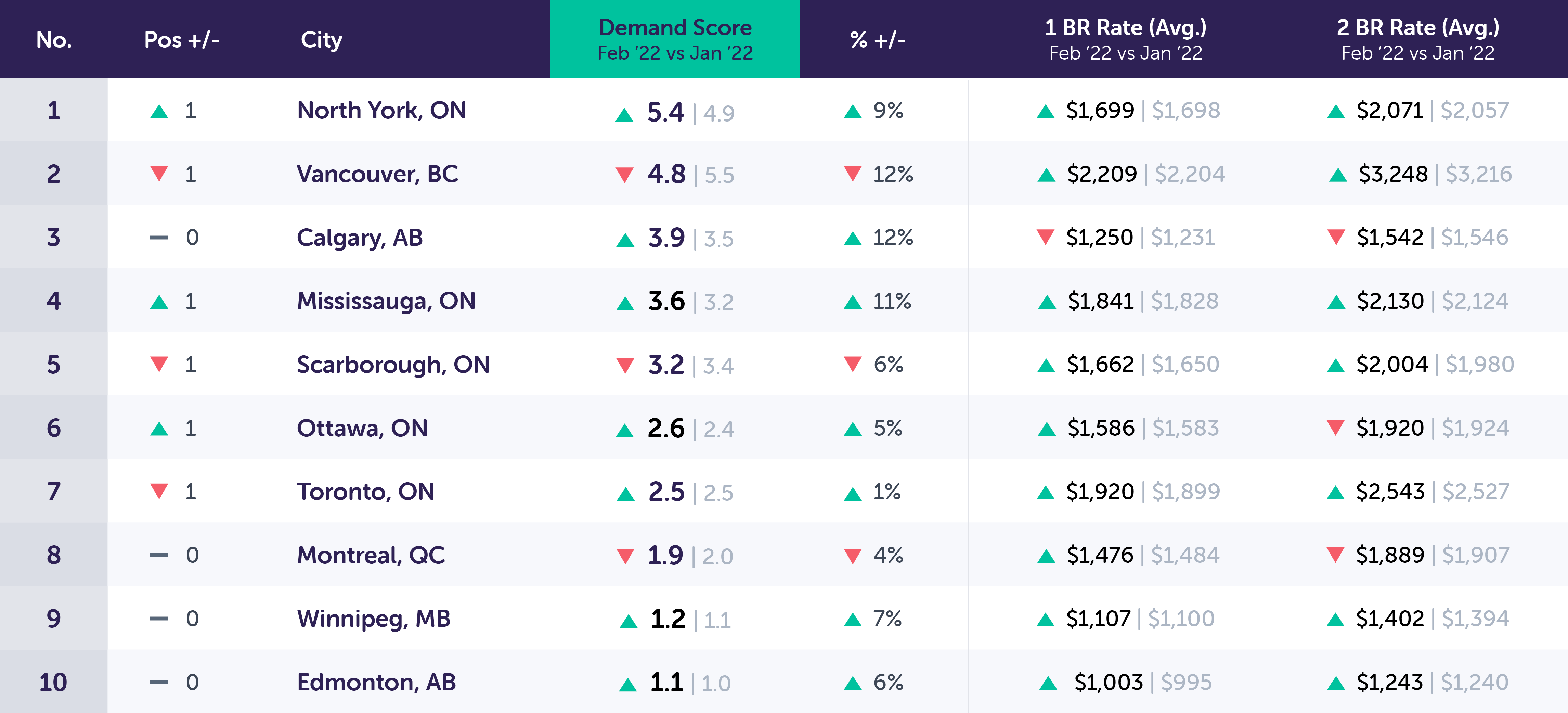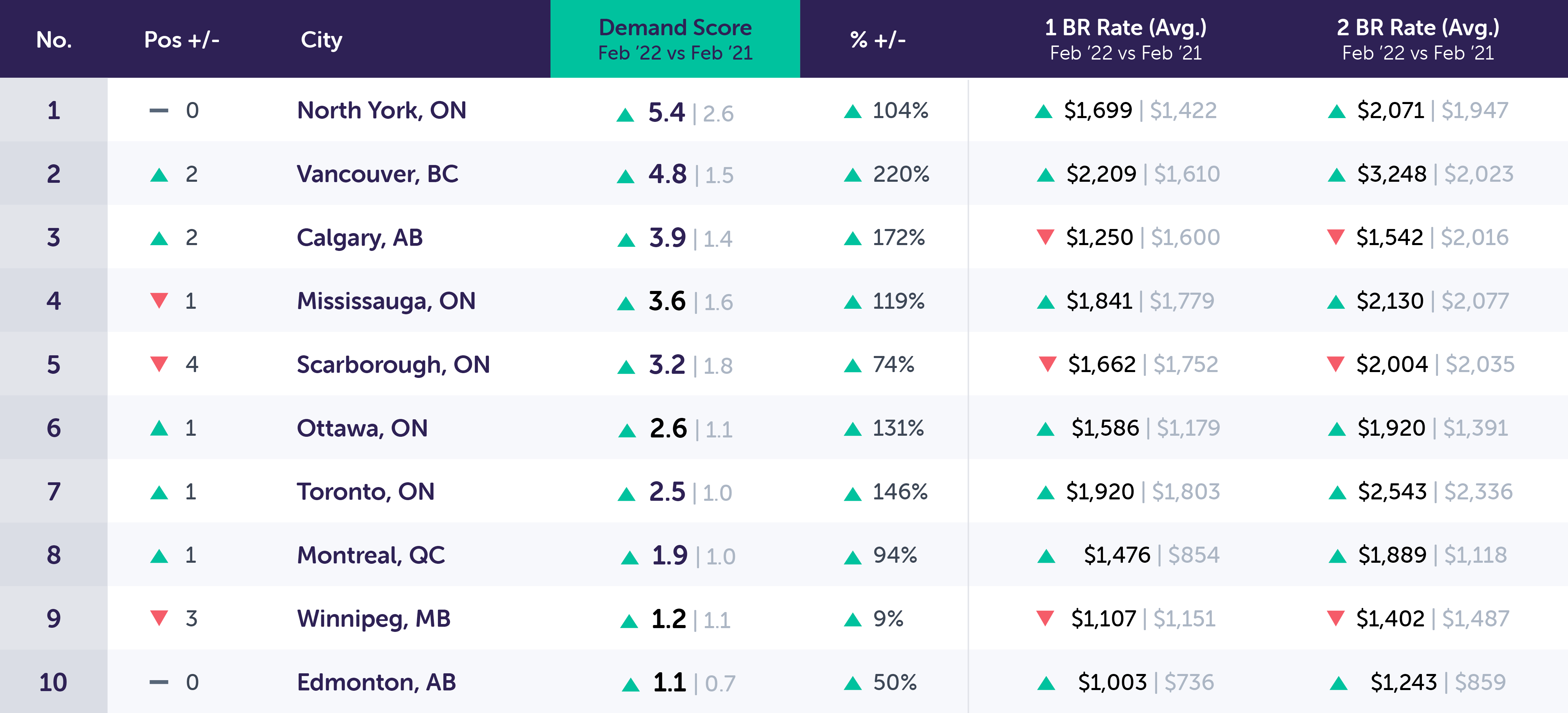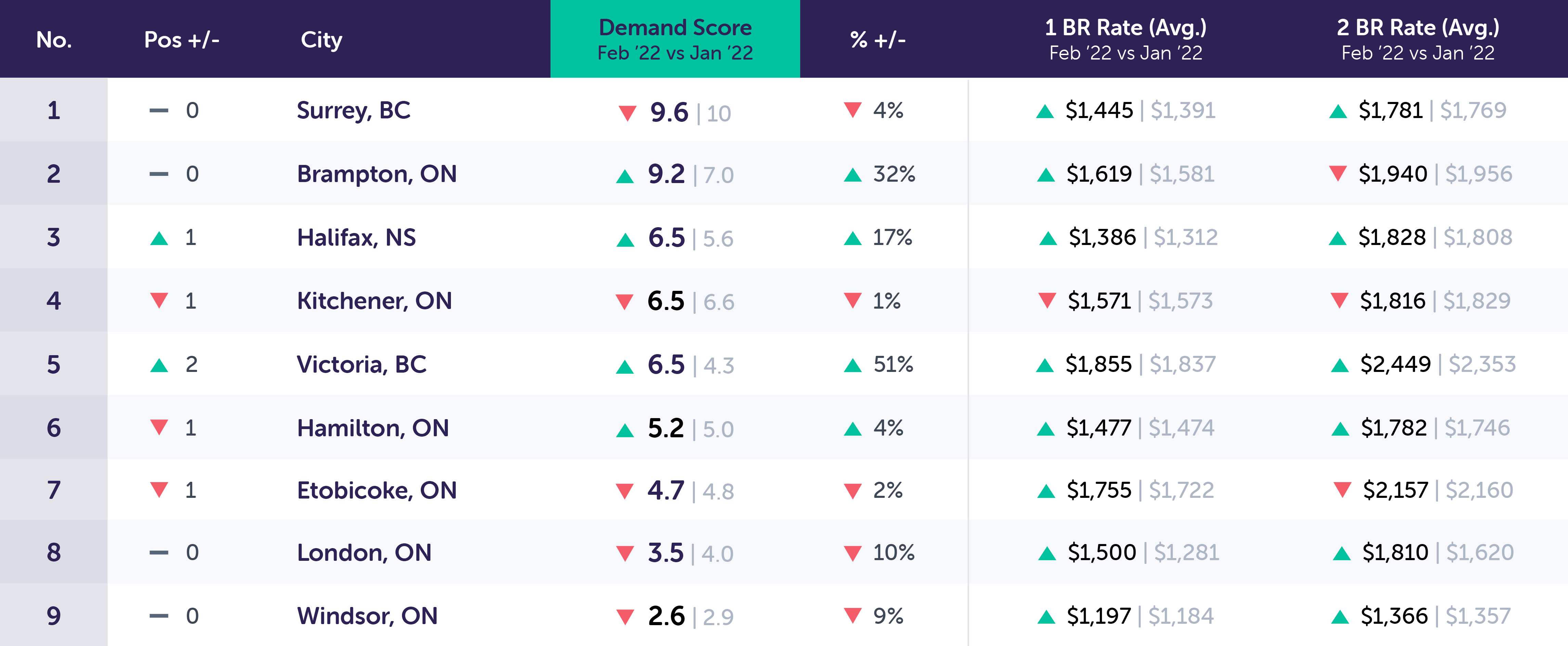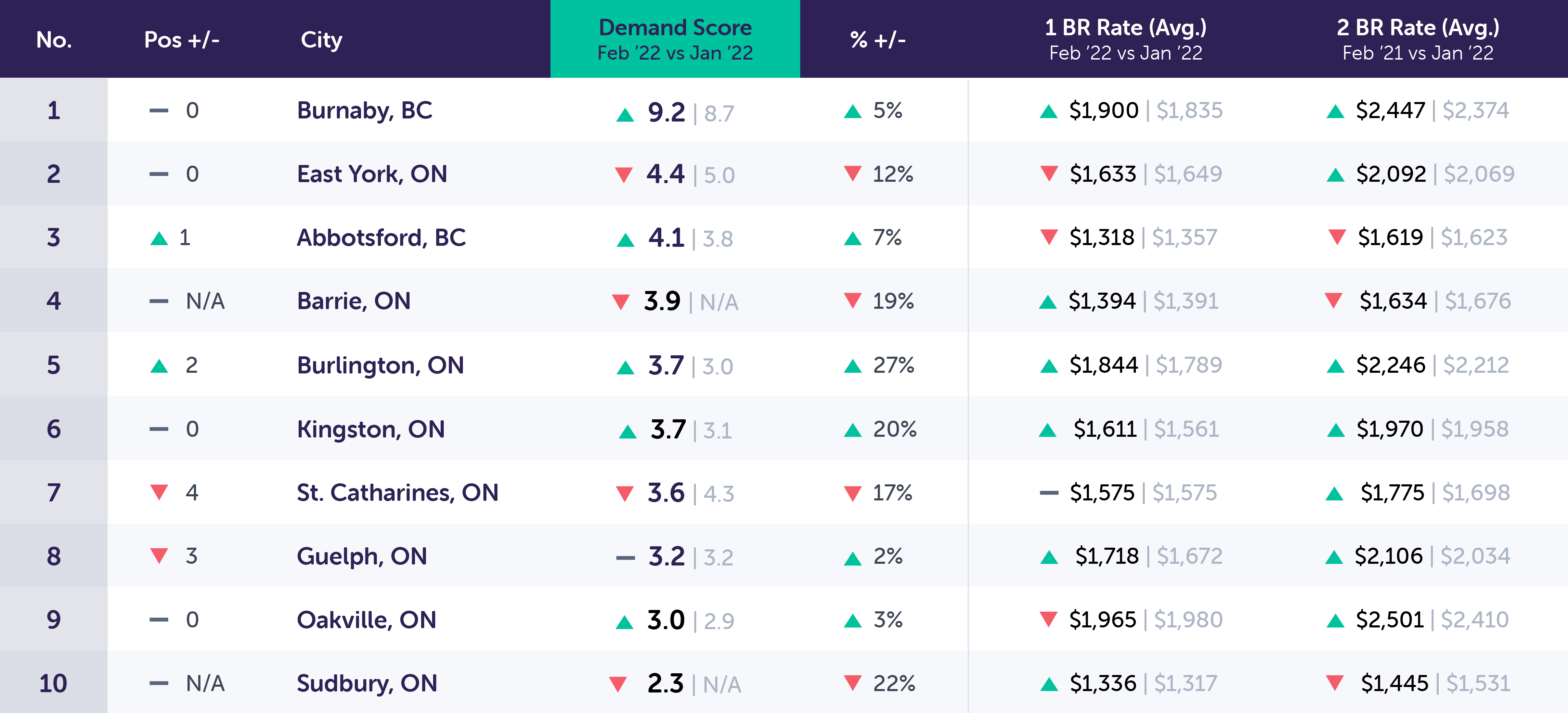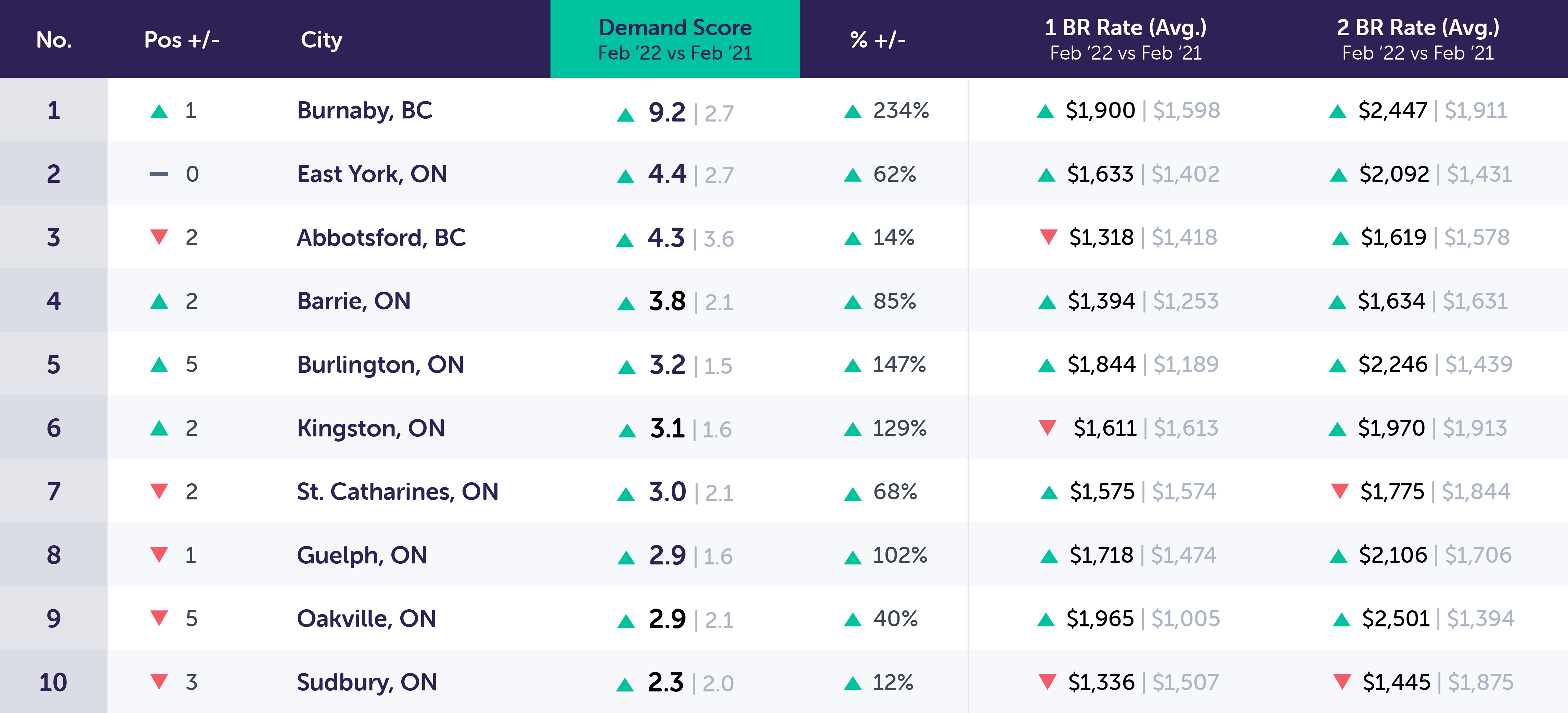
Rentsync National Rental Demand Report: March 2022
Executive Summary
In this comprehensive national rental demand report, we outline significant changes in unique leads per property across Canada. The data presented here is the largest data-backed analysis of rental market demand in Canada using aggregate ILS data (over 20 rental listing sites).
The data included in the Rentsync National Rental Demand Report can be used to compare and contrast demand and lead volume for the properties you manage within a given city and will allow you to make more sound decisions on marketing and advertising.
As you observe demand and unique lead volume percentage, it's possible to measure this against your own metrics, and see whether you are in line with current industry trends, and if not, how to pivot your strategies as a result.
Methodology
In order to present this data, Rentsync has determined three key calculations for each area of the report, they are as follows:
Demand Score: Our demand score is rated out of 10 (with 10 being the highest score a city can receive), and is calculated based on unique leads per property, per city, and compared against benchmark data.
For example: If Surrey, BC received a demand score of 9.6 this month, versus 10 last month. Therefore, Surrey experienced an increase in its demand score by 0.4 this month.
Demand Percentage (% +/-): This is determined according to the year-over-year (YOY) or month-over-month (MOM) increase or decrease in unique leads per property.
For example: The month-over-month unique leads per property in Surrey, ON went down 5% in February versus January. In February 2022, the year-over-year Demand Score in Surrey, ON went up 4.0 points based on an increase of 71% unique leads per property compared to February 2021.
Position: The position is determined by unique leads per property, with cities that have at least *20 properties or more. The position will vary depending on demand.
For example: This month, Surrey, BC remained number one on the Top 40 Canadian Cities in Demand. Year-over-year Surrey, BC is up 1 spot since last year.
*The following report provides month-over-month ILS data for January 2022 versus February 2022, as well as a year-over-year comparison from February 2022 versus February 2021. It also outlines the month-over-month and year-over-year trends in primary, secondary, and tertiary markets.
Key Takeaways:
Month-over-month (M/M): Overall, the average leads per property from January 2022 to February 2022 increased by +2%, although average inquiry volume has increased, the overall supply of properties decreased by -5.9%, while the number of prospects shrank by a marginally lower -4%. This resulted in leads per property becoming more concentrated month over month. The month-over-month snapshots are as follows.
Month-Over-Month (M/M)
-
Primary: Unique leads per property are up +1%
-
Secondary: Unique leads per property are up +2%
-
Tertiary: Unique leads per property are up -5%
*Although typically experienced in December and January we are seeing a reduction in the overall demand for rental product across the country regardless of market type. Both the supply of available properties, as well as the volume of incoming inquiries has reduced month over month marking an end to the strong and maintained growth that has been a mainstay of the previous 2 quarters.
Year-over-year (Y/Y): Overall, in Canada, our multifamily demand score shows an increase of +90.07% in February 2022 versus February 2021. Although overall demand figures are up; both prospects and available properties are down by -46.8%, and -36.6% respectively. The loss in prospects is primarily due to the loss of Facebook marketplace as a source of property leads, while a reduction in property availability is simply a result of strong leasing activity. These conditions suggest that Canada has likely returned to its pre-covid leasing conditions, and the supply of available units continues to decrease at a higher relative rate than that of the demand for apartments. Overall, the year-over-year (February '22 vs February '21) market snapshots are as follows:
Year-Over-Year (Y/Y)
-
Primary: Unique leads per property are up +108%
-
Secondary: Unique leads per property are up +132%
-
Tertiary: Unique leads per property are up +55%
*The year over year analysis indicates that rental demand has maintained an upward trajectory as markets returned to pre covid fundamentals and many individuals began to return to the rental market.
Top 40 Canadian Cities in Demand
*Demand is determined by calculating unique lead volume per property by market. Due to a decrease in available properties in the rental housing market, this report will only highlight the top 40 cities in Canada based on our threshold that requires at least 20 properties to be included in our data sample.
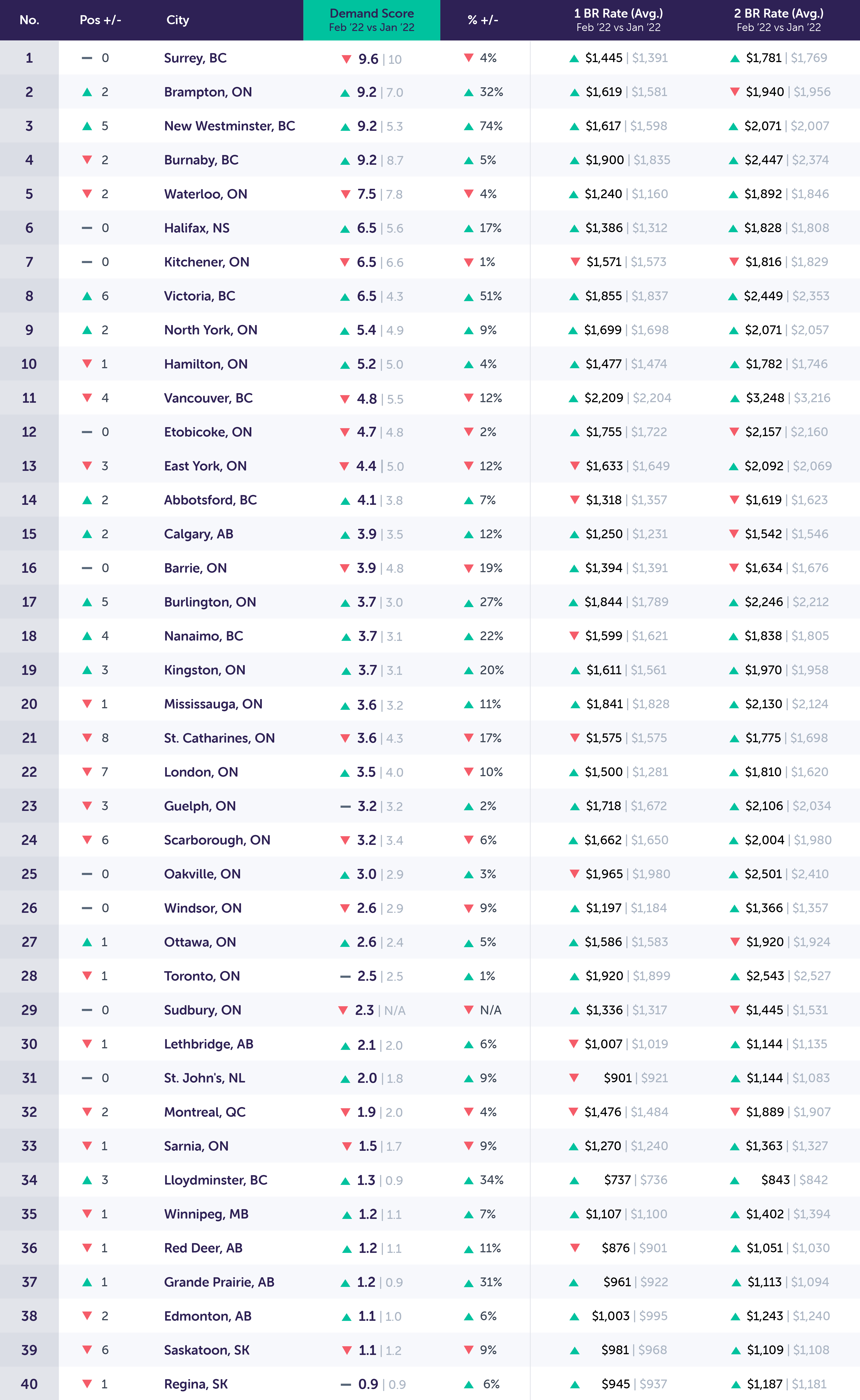
*Please note we have made improvements to our report to better serve readers looking for more in-depth rental market insights.
Notable Changes in Demand Over the Past Month
Overall, Canadian cities experienced a decrease in unique leads per property month-over-month (January 2022 to February 2022).
Top 10 Canadian Cities in Demand Drill Down (M/M): February 2022 vs. January 2022
Key Trends for Top 10 Canadian Cities in Demand (M/M)
*Although typically expected in January we are only seeing a slowdown in renter traffic (although very small) in February. The top ten markets are highly representative of the broader Canadian landscape with overall demand scores increasing as a result of the disproportionately higher decrease in available supply relative to the decrease in inquiry traffic. Rental rates have similarly continued trending upwards likely as a result of demand outstriping the available supply of available units.
Top 10 Canadian Cities Drill Down (Y/Y): February 2022 vs. February 2021
Key Trends for the Top 10 Canadian Cities in Demand (Y/Y)
*Year over year we see the continued long term normalization of renter traffic and inquiry volume. The biggest gainers throughout this period remain secondary markets with significant long term and continued growth in renter traffic. Surrey specifically presents an interesting case study taking the top spot in our rankings, while also experiencing the lowest year over year growth in our demand scores of +71%. Likely in part because Surrey is in close proximity to both Richmond and Vancouver it maintained strong inquiry volume throughout 2021 as many residents sought outlying communities in favour of more dense urban markets.
The trend of many moving away from primary markets has lessened to an extent with smaller tertiary markets representing the largest overall share of inquiry loss as households return to primary and secondary markets for their improved amenitization and quality of life.
This does not however negate the value posed by tertiary markets as they remain strong attractors for young families, and will continue to be in high demand as many continue to be priced out of major housing markets.
An Analysis of Key Canadian Markets
In order to better segment our data and analyze what is happening within specific markets across Canada, we have broken down our data into 3 key market segments:
-
Primary (Populations Over 600K)
-
Secondary (Populations Between 600-235K)
-
Tertiary (Populations Between 235-100K)
Here we will gain a deeper perspective on demand across larger populations and any movement due to the impact of COVID-19 on the rental market.
Key Takeaways:
Both the supply of available units, and the demand posed by prospective renters has seen a gradual decrease. There has been an ongoing trend of available supply shrinking at a greater relative rate than inquiry volume, however this trend is beginning to shift with both the volume of inquiries and available properties decreasing almost parallel with one another; which has resulted in overall unique leads per property to halt the growth experienced.
Primary Markets (Populations >600K)
Primary Market Drill Down (M/M): February 2022 vs. January 2022
Notable Changes in Primary Markets Over the Past Month
*Overall unique leads per property increased by +1% in primary markets this month.
Primary markets which have recently been the strongest earners month over month have now experienced what could be described as sluggishness in the growth of their unique leads per property of only +1% month-over-month (compared to +33% between December to January). This can be attributed to a combination of the extended period of strong leasing which has since been able to reabsorb the unoccupied units within major markets, and potentially a delayed response to the typical seasonality expected in renter traffic.
(See the year-over-year analysis below, for more perspective on demand in primary markets.)
Primary Market Drill Down (Y/Y): February 2022 vs. February 2021
Notable Changes in Primary Market Demand Over the Past Year
*Overall, year-over-year primary market unique leads per property have rebounded when compared to the same time last year and have increased +108%. Ongoing and continued reopening of major cities has also had a major impact on this strong yearly growth as the hope of ending covid related restrictions motivated many to return to major markets.
Alongside the growing demand for apartments, we also experience growth in rental rates which suggest that not only has demand rebounded, but that market conditions are gradually returning to those experienced prior to covid and that incentives are likely to gradually disappear as competition for renters declines. This has allowed for the continued growth and acceleration of rental rates within metropolitan areas after over a year of stagnation. It should be noted however that some of the growth in rental rates is due to the reabsorption of a majority of the more affordable units in major markets, along with a reduction in the availability of concessions.
Secondary Markets (Populations ~600-235K)
Secondary Markets Drill Down (M/M): February 2022 vs. January 2022
Notable Changes in Secondary Market Demand Over the Past Month
*Secondary markets saw an increase of +2% unique leads per property this month, and a notable drop in supply within many markets; with only 9 cities present which contained 20 properties or more in February (Compared to 10 the previous month).
Many secondary markets also continue to experience price fluctuations month over month, and while this would typically be attributed to increased competition amongst available properties, we believe it may be due to the availability of rental product over time. As renters begin to re-enter the rental market, they are increasingly demanding higher quality features and finishes from accommodations. Secondary markets typically contain a substantial amount of older stock rentals, many of which remain under amenitized with minimal features. This has likely led renters to favour those units which offer superior features in favour of lower priced units. This suggests that moving forward it will be increasingly important for property owners to invest in property renovations in order to maintain a competitive edge in 2022.
Secondary Market Drill Down (Y/Y): February 2022 vs. February 2021
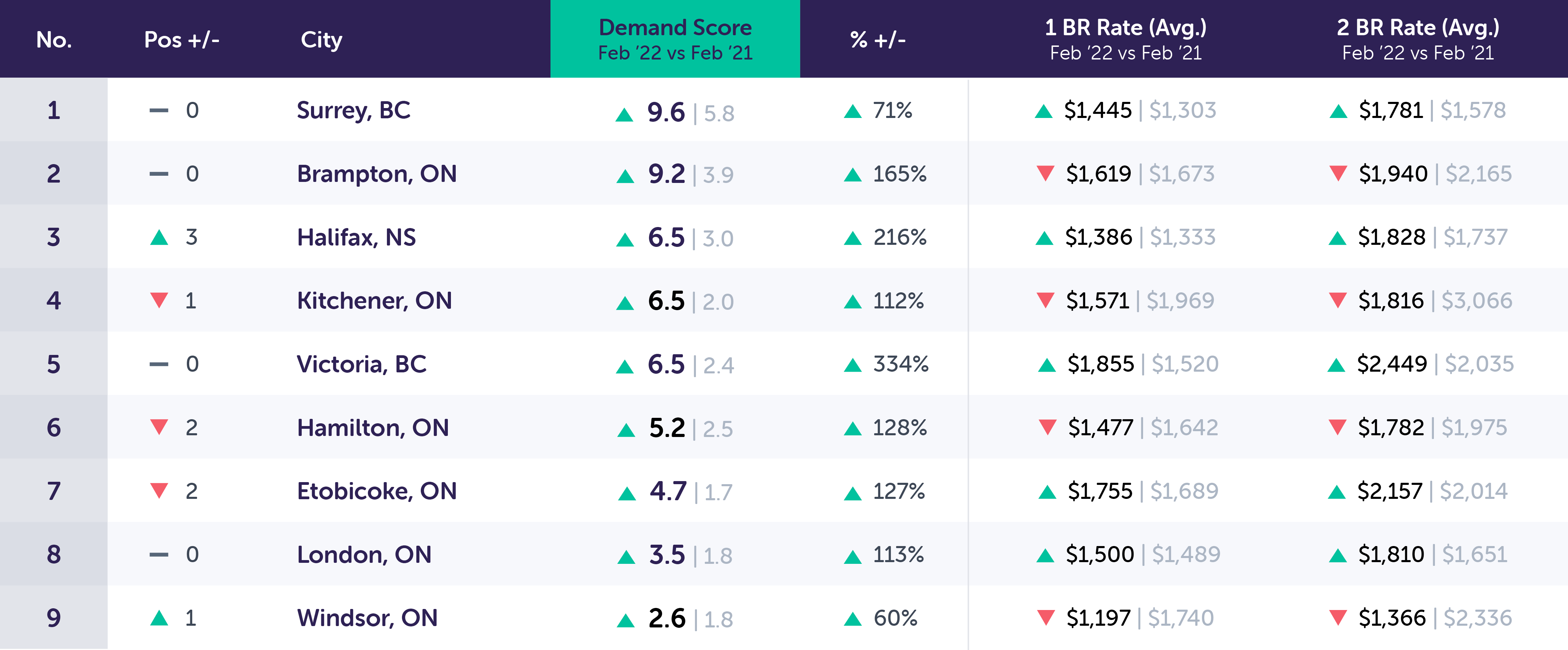
Notable Changes in Secondary Market Demand Over the Past Year
*Overall, unique leads per property are up +132% in secondary markets this year versus this time last year. The significant year-over-year increase suggests that secondary markets are the largest earners over the previous 12 months with substantial growth in unique leads per property. In alignment with both primary and secondary markets we have also seen a decrease in the overall availability in properties which has outpaced the decrease in rental inquiries.
The markets which we identify as having experienced the greatest overall level of maintained growth are those which offer strong employment prospects within their borders and are less reliant on outlying communities for employment. This suggests that long term growth is likely to be experienced within secondary markets which act as regional hubs and are able to maintain a draw on smaller local communities.
Tertiary Markets (Populations ~235-100K)
Tertiary Markets Drill Down (M/M): February 2022 vs. January 2022
Notable Changes in Tertiary Market Demand Over the Past Month
*Unique leads per property decreased by -5% this month versus last month in tertiary markets.
This marks a stark departure from what has been experienced over the last 6 months, or even what is being experienced in major markets. Inquiry volume has decreased, while the available supply of properties has remained relatively stable. This may suggest that the return to pre-covid conditions has been achieved, and that the general interest in tertiary markets was mostly a temporary phenomenon.
(See the year-over-year analysis below, for more perspective on the rise in demand in tertiary markets.)
Tertiary Markets Drill Down (Y/Y): February 2022 vs. February 2021
Notable Changes in Tertiary Demand Over the Past Year
*Overall, unique leads per property are up in tertiary markets, increasing +55% this year versus the same time last year. Higher than last month's year-over-year increase of (+26.5%) this is likely due to a lack of the typically expected seasonal decline in lead volume within the first few months of 2022 which resulted in higher long term growth figures.
Although tertiary communities experienced gains throughout the pandemic in regards to increasing rental demand, some of this growth has receded indicating some of the appeal which had attracted many households has dissipated and many are now looking to return to larger markets. This trend is most evident in rural communities as opposed to those which are within commuting distance of a major market or offer proximate employment opportunities. Regardless, the overall trend of households' willingness to move into smaller communities persists to a smaller extent and is likely to continue as a staple within the Canadian rental industry moving forward. Additionally, rent rate growth in tertiary markets are notably much lower than those in secondary and primary markets, an indication that rental demand and competition for these properties is not as strong.
Conclusion
The data shown suggests that while 2022 started off strong with maintained growth in inquiry volume, and a continued resurgence to major markets; we were not able to stave off the effects of a strong leasing trajectory and demand has subsequently begun to decrease. A substantial proportion of the unleased units which remained vacant throughout much of 2020 and 2021 have been released which reduced available inventory; while demand has similarly been satiated with many households having already returned to the rental market and leased units thus creating a reduction in the volume of inquiries being submitted.
February is typically expected to show signs of stagnation as the cold weather persists and many remain unwilling to move. We expect that as the weather continues to improve and temperatures rise we will see a resurgence in renter inquiry traffic as was the case pre-covid.
These factors suggest that although we are in the midst of a minor monthly slump, it is likely we will likely see greater momentum as we move towards the spring market, with continued growth in rental demand, and in some cities, rental rates. The resurgence of major markets will be compounded by the already speculative nature of real estate in these communities to create significant demand across all property classes and the overall demand for purpose-built rental is likely to continue to grow.
We will continue to monitor, and provide an in-depth data analysis, month-over-month, and year-over-year to provide you with the most accurate insights that can help to support your ongoing marketing and advertising strategies, especially as we navigate through these unprecedented times.
